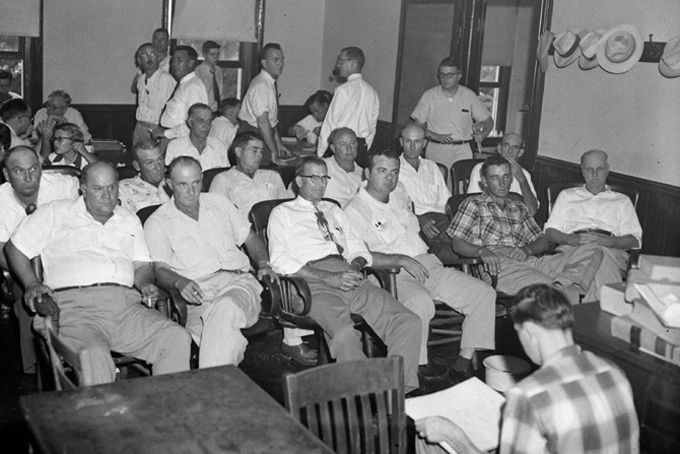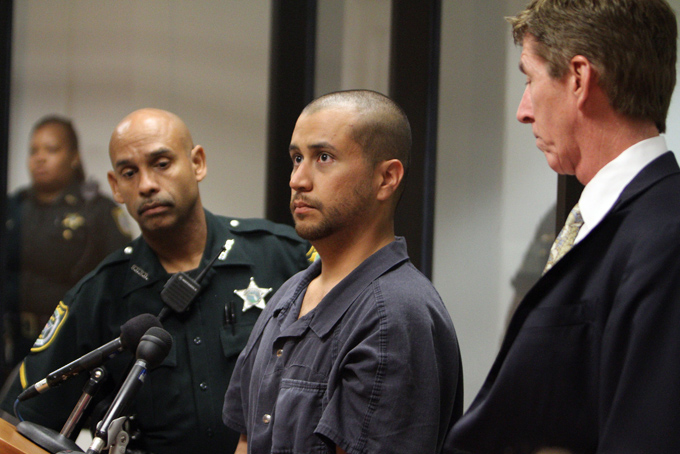
In this Sept. 20, 1955 file photo, jurors sit in a courtroom in Summer, Miss. for the trial of Roy Bryant and J.W. Milam who are charged with the murder of 14-year-old Emmett Louis Till. Acquitted by the all-White jury, the two confessed to the killing of the Black teenager in a 1956 Look magazine article. From left in the front row are Gus Ramsey, James Toole, E.L. Price, J.A. Shaw Jr., Ray Tribble and Ed Devaney. In the second row are Travis Thomas, George Holland, Jim Pennington, Davis Newton, Howard Armstrong and Bishop Matthews. (AP Photo/File)
(AP) —Focus on the details, and the cases seem very different. One was killed by virulent White racists, the other by a part- Hispanic neighborhood watchman who insists he faced a vicious attack. One was weighted down and dumped in a river; in the other case, police were called by the shooter himself.
Six decades and myriad details separate the deaths of Emmett Till and Trayvon Martin, two Black teenagers felled by violence. Yet in the way America reacted to Martin’s death – and the issues that echoed afterward – his case has created a national racial conversation in the much same manner as the saga of Till, infamously murdered in 1955 for flirting with a White woman.
Plenty of people do not see the Martin case as about race at all. But for others who study America’s racial past and present, each killing is a defining moment for its era – a fraught microcosm of what we are, and what we are trying to become.
“Trayvon Martin is today’s race case,” says Christopher Darden, a prosecutor in the O.J. Simpson murder trial, another defining American moment. “I don’t know that anybody can really sit there and objectively look at the evidence. It arrives with so many different kinds of emotions.”
Just as the Till saga remains a searing archetype of the brutal segregation that gave rise to the civil rights movement, the Martin case captures the ambiguous meanings of race in America at a time when both the president and the lowest segments of society are Black.
Emmett Till showed what needed to be done in 1955. Now, Trayvon Martin reveals to us the racial landscape of 2013.
“Trayvon Martin certainly is the Emmett Till of the hoodie generation,” says Michael Skolnik, a board member of The Trayvon Martin Foundation and president of GlobalGrind.com.
“This case represents so much for our country,” Skolnik says. “It represents issues of race, issues of police priorities for different communities. It represents the status of young Black men in America.”

In this Thursday, April 12, 2012 file photo, George Zimmerman, center, stands with a Seminole County Deputy and his attorney Mark O’Mara, right, during a court hearing in Sanford, Fla. Zimmerman was charged with second-degree murder in the shooting death of 17-year-old Trayvon Martin. (AP Photo/Orlando Sentinel, Gary W. Green, Pool)
On a February night in 2012, Martin was returning to his father’s house from the store, unarmed, his hoodie up in a light rain. George Zimmerman, a volunteer neighborhood watchman, saw the 17-year old and called police to report a “suspicious” person “up to no good.” Minutes later, a bullet from Zimmerman’s gun was in Martin’s chest.
Did Zimmerman think Martin was suspicious because he was Black, or was he justly guarding his neighborhood? Did Martin attack Zimmerman? If Zimmerman acted based on race, is that manifestly unjust or just common sense?
Such questions, and the lineage of American historical events behind them, have turned Martin’s story into one that far transcends the facts of the case.
“I’ve been doing work around police brutality and racial hate crimes for over 20 years, but I’ve never seen one resonate with so many people like the Trayvon Martin situation,” says Kevin Powell,president of the advocacy group BK Nation and editor of “The Black Male Handbook: A Blueprint for Life.”
“He became this symbolic figure for how much has not changed in America in spite of a Black man being in the White House,” Powell says.
To some, the Martin-Zimmerman case is about media distortion when it comes to race. Some view it through the prism of whether Florida’s “stand-your-ground” law is legitimate.
And for others, the case symbolizes that Black people see racism when there is no evidence of it.
“I reject the idea that this happened specifically because of color,” says Mychal Massie, a columnist and former chairman of the Black conservatives leadership group Project 21.
“I’m not saying that Martin deserved to be shot,” Massie says. “I’m also not saying he was a paragon of virtue. Indications are he was not singled out because he was Black. He was singled out because he was there, Zimmerman was doing his job as a neighborhood watchperson, and he saw a stranger.”
Massie strenuously objects to any comparison between Till and Martin. Till, Massie says, died in “a different time.”
There certainly is no comparison between the killers, or the circumstances surrounding their actions: Two White men abducted the 14-year-old Till, pistol-whipped and shot him, then dumped him in a river with a weight barb-wired around his neck. Zimmerman, whose father is White and mother is from Peru, identifies himself as Hispanic. He says he fired in self- defense because he was being viciously beaten by Martin.
Yet Martin, like Till, died at a pivotal moment in U.S. racial history.
This combination of photos from 1955 and 2009 shows Emmett Till in Chicago, about six months before he was killed, and Trayvon Martin in an aircraft hanger. Six decades and myriad details separate the deaths of Till and Martin, two Black teenagers felled by violence. Yet in the way America reacted to Trayvon’s death – and the issues that echoed afterward – his case has created a national racial conversation in the much same manner as the saga of Emmett, infamously murdered in 1955 for flirting with a White woman. (AP Photo/File)
In this Sept. 20, 1955 file photo, Mamie Bradley, the mother of Emmett Louis Till, receives a subpoena from Sheriff H.C. Strider, right, in a courtroom in Tallahatchie, Miss. to appear as a witness in the trial of two White Mississippi men who accused of murdering her 14-year-old son. Roy Bryant and his half-brother J.W. Milam, were acquitted by an all-White jury in 1955. They confessed to the killing in a 1956 Look magazine article. (AP Photo/File)
The Brown v. Board of Education case desegregating American schools had just begun the march toward equal rights, but Till’s death signaled that the hardest battles had yet to be fought. Likewise, Martin died when a Black man was leading the country for the first time.
But Raynard Jackson, a Black conservative commentator, says the fact of a Black president didn’t stop a Black kid minding his own business from being considered a criminal.
“It was based on a mindset of prejudice and superiority: ‘Who are you to walk in my neighborhood?'” Jackson asserts.
Reams of scientific evidence and real-life experiences suggest such profiling is widespread, and millions of people can feel its truth in their bones. But in the case of George Zimmerman, who exhibited no previous racist behavior of record, it’s still nothing but an assumption and almost impossible to prove.
That’s another defining feature of today’s racial challenges: They’re much more subtle than in 1955, and thus often harder to discuss or quantify.
Darden’s own judgment tells him that race was a factor in Zimmerman placing Martin under suspicion: “It had to be. Race is a factor, a point of fact that people consider when they evaluate someone.”
For Massie, the significance of the Martin case is simple: Black males commit a disproportionate percentage of crimes. “What it shows,” he says, “is the continued predilection for misbehavior by so many young urban people, regardless of color.”
“The tragedy of Trayvon Martin is that, if as many of us believe he initiated this assault, he paid the ultimate price for a bad decision,” Massie says.
Trayvon Martin: victim or aggressor? George Zimmerman: racist or neighborhood protector? As with America in the Emmett Till era, much of today’s race problem rests on the fact that America can’t reach even a semblance of consensus on the problem.
“I think White America has one way of viewing race, because of their experiences, and American people of color have a very different perspective, because of their experiences,” says Powell, the activist.
“If we are to truly have one America, then we’ve got to talk and listen to each other,” he says, “and to understand that Trayvon Martin murder is an American tragedy, not a Black tragedy.”
Jesse Washington covers race and ethnicity for The Associated Press. He is reachable at https://www.twitter.com/jessewashington or jwashington@ap.org.